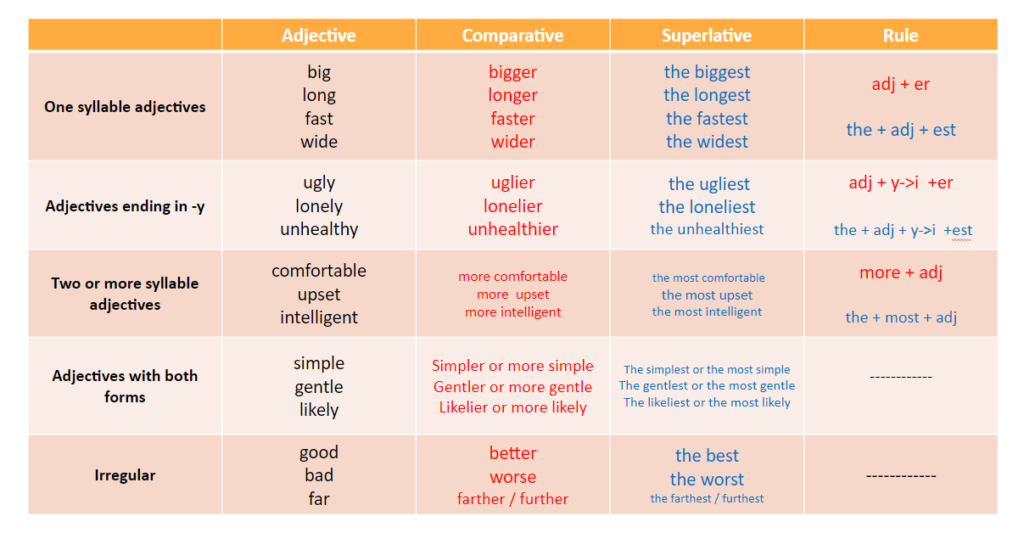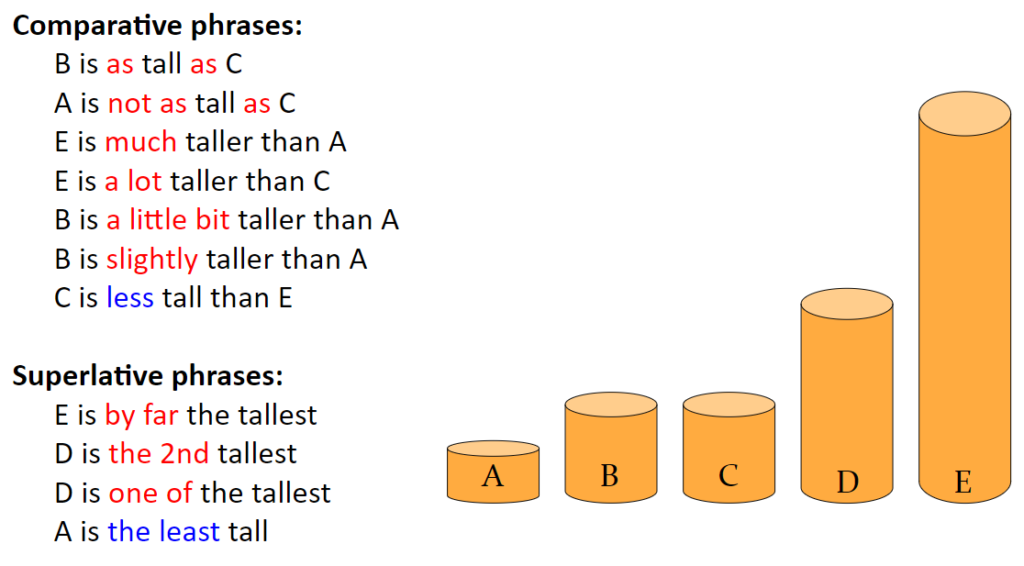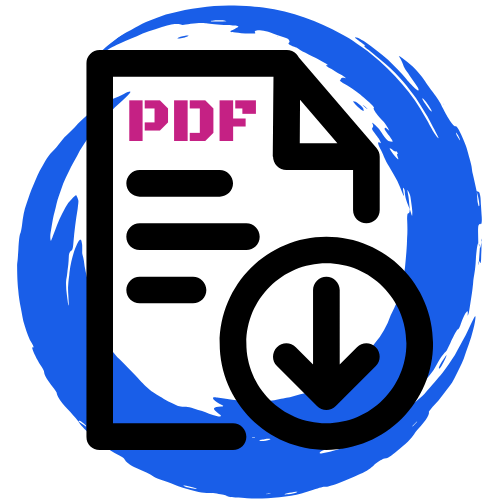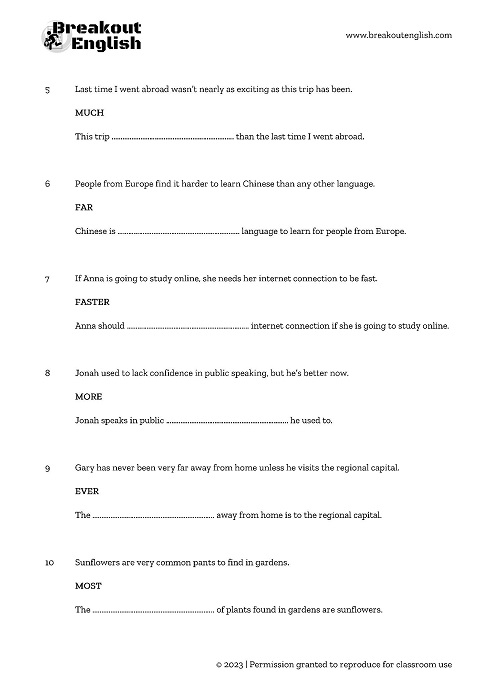Comparatives and superlatives exercises are common in English courses, but can be tricky, yet they play a crucial role in exams such as the Cambridge B2 First. While these exercises may appear simple at first glance, they can pose challenges for students. Let’s explore the rules for comparatives and superlatives. Then, you can download comparatives and superlatives exercises based on Use of English Part 4, the Key Word Transformations task, in the Cambridge B2 First exam.
We’ve put the key word transformations from this page and loads more in a book that’s available for digital download and as a paperback on Amazon.
GET 250 B2 FIRST (FCE) KEY WORD TRANSFORMATIONS:

Contents
Rules for comparatives and superlatives
Comparative adjectives are used to compare two things. They indicate a higher or lower degree of a particular quality or characteristic. When using comparative adjectives, we need to follow certain rules and structures. Let’s look at them in detail:

Comparative adjectives
For one-syllable adjectives, we add “-er” to the end of the adjective to form the comparative. For example:
- Fast → Faster
- Tall → Taller
- Big → Bigger
If the adjective ends in an “e,” we only add “-r” to form the comparative. For example:
- Large → Larger
- Wise → Wiser
If the one-syllable adjective ends in a single consonant preceded by a single vowel, we double the consonant. For example:
- Big → Bigger
- Hot → Hotter
- Thin → Thinner
If the adjective ends in the letter “y”, this changes to an “i” before adding “-er” For example:
- Easy → Easier
- Healthy → Healthier
If the adjective has two or more syllables, we usually use “more” before the adjective to form the comparative. There are only a few exceptions to this rule. For example:
- Beautiful → More beautiful
- Interesting → More interesting
Irregular Comparative Adjectives: Some adjectives have irregular forms in the comparative form.
- Good → Better
- Bad → Worse
- Far → Farther/Further
Using “than“
Comparative adjectives are often used in sentences to make a comparison between two things. The word “than” is used to introduce the second element of the comparison. For example:
- John is taller than Peter.
- This is a more interesting book than that one.
Superlative adjectives
Superlative adjectives are used to compare more than two things or people. They indicate the highest or lowest degree of a quality or characteristic.
To form the superlative degree, we add “-est” to the end of the adjective for one-syllable adjectives:
- Fast → Fastest
- Tall → Tallest
If the adjective ends in an “e,” we only add “-st”:
- Large → Largest
- Wide → Widest
If the adjective ends in a single consonant preceded by a single vowel, we double the consonant and add “-est”:
- Big → Biggest
- Hot → Hottest
- Thin → Thinnest
If the adjective ends in the letter “y”, this changes to an “i” before adding “-est” For example:
- Easy → Easiest
- Healthy → Healthiest
For adjectives with two or more syllables, we use “the most” before the adjective:
- Beautiful → The most beautiful
- Interesting → The most interesting
Using “the“
When using superlative adjectives, we typically use the definite article “the” before the adjective to indicate that something is the highest degree of a quality.
- Mount Everest is the highest mountain in the world.
- The most exciting night of my life was in Budapest.
Comparative and superlative phrases
There are several other ways to express comparatives and superlatives by modifying the base grammar. The phrases below tend to show the extent of the difference between things. Sometimes things are equal, or there is a small difference, or there is a large difference. This can be an important factor to take into account.

Comparative and superlative adverbs
Comparative and superlative adverbs are used to compare the intensity or manner of an action or event. They function similarly to comparative and superlative adjectives, but modify verbs, adjectives, or other adverbs instead of nouns. Let’s explore how comparative and superlative adverbs are formed and used.
Comparative and superlative forms of short adverbs, which do not end in “-ly,” are formed similarly to adjectives. To create the comparative form, add “-er” to the adverb, and for the superlative form, add “-est” to the adverb. For example:
Adverb: Fast
- John runs faster than Mary.
- Sarah is the fastest runner in the race.
Adverb: Hard
- Tom works harder than his colleagues.
- This is the hardest test I’ve ever taken.
Adverb: Late
- She arrived later than expected.
- The latest bus leaves at 10 PM.
When forming the comparative and superlative forms of adverbs that end in “-ly,” we utilise “more” to create the comparative and “most” to establish the superlative.
Adverb: Carefully
- She walked more carefully on the slippery floor.
- He handled the fragile vase with the utmost care.
Adverb: Quickly
- The cheetah runs more quickly than any other land animal.
- She solved the puzzle most quickly in the competition.
Comparatives and superlatives exercises
This comparatives and superlatives exercises worksheet contains 10 sentences where you will be required to transform the given sentence using the appropriate comparative or superlative form. These types of Key Word Transformations often appear in the Cambridge B2 First (FCE) exams. While comparatives and superlatives are simple to understand, exam candidates at this level can still have difficulty using them accurately. Don’t forget the details, the spelling rules and the variety of phrases that can be used. This exercise will help improve your knowledge of comparatives and superlatives.
EXAM PART: Use of English Part 4 – Key Word Transformations
EXAM SKILLS: Using grammar appropriate to the level (B2), transformations
TIME: 20 minutes + feedback
PREPARATION: One copy of the worksheet per student
Download





